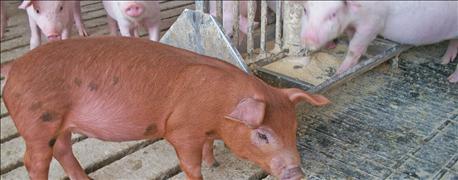
As part of an industry-wide and national effort to communicate the latest research on porcine reproductive and respiratory syndrome, and other swine diseases, the Swine Health Information Center issues monthly reports to stakeholders.
In recent reports, supported by USDA and the pork checkoff, two articles appeared that discussed swine barn location and windbreaks, and their impact specifically on PRRS. The author, Andreia Arruda, a University of Minnesota veterinarian who also holds a Ph.D., offered research discussion on locating barns on top or at the bottom of hills, and whether or not to plant trees and shrubs as farm windbreaks. Here are edited versions of her reports.

ENVIRONMENTAL IMPACTS: Scientists are examining data that support where to locate swine barns on the landscape as well as the importance of farm landscaping, specifically, planting trees.
Barn on top or at the bottom of the hill?
Swine sites located in areas with higher slope showed reduced incidence of PRRS virus breaks. Scientists concluded this after considering swine density in an area, herd size, geographical location and production system.
Researchers used PRRS incidence data from 2009 to 2016 from the Swine Health Monitoring Project involving more 700 swine breeding herds. Data on PRRS incidence, herd size and geographical location were extracted from the SHMP database, and computer images describing terrain elevation of the farms were gathered.
Modeling showed that swine sites in areas with slopes of 9% or higher were protected from PRRS breaks, compared to sites located in a terrain of less than 2% slope. In other words, they showed a lower incidence rate for PRRS. The altitude of the terrain, measured as meters above sea level, was not statistically significant as a factor in PRRS incidence.
Arruda noted that it was challenging to interpret results, because air movement and virus survivability and transmission are determined by a complex combination of wind direction and speed, humidity and temperature, as well as positioning of neighboring swine sites.
“However, it is reasonable to hypothesize that being located, or not, in a slope is a proxy for other risk factors for PRRS, including distance to main roads and traffic of transport vehicles used both for transportation of live animals and deliveries of industry necessary supplies,” she wrote.
To plant or not?
As an extension of the barn location study, researchers determined that sites in areas with shrubs and trees had reduced incidence of PRRS virus compared to sites in cultivated areas.
Modeling showed that sites in areas with shrubs and/or herbaceous cover reduced the incidence of PRRS by 0.7. Being located in areas with needle-leaved and broad-leaved trees reduced the incidence of PRRS by 0.6 and 0.4, respectively. Explained another way, the research suggests that swine sites being located in areas with shrubs or trees decreases the incidence rate by at least 30% compared to sites being located in cultivated areas.
Arruda noted that the protective effects from green coverage are not new in the poultry industry, even though this has never been described for PRRS.
“Planting trees around poultry farms has been described as beneficial not only because trees can provide shade and for their visual appeal, but also for filtering airborne pathogens and for reducing odor emissions,” she noted, citing 2008 research.
She added, too, that the computer imagery dates back to the early 2000s, and that land features may have changed since then. U-M scientists plan to do a follow-up study to validate the preliminary findings.
About the Author(s)
You May Also Like






